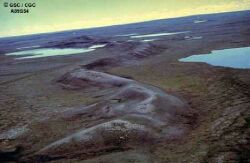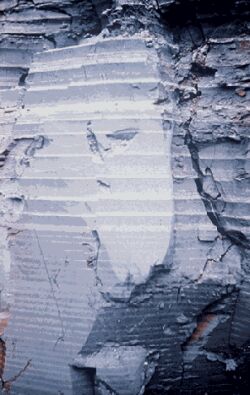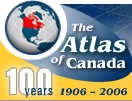|
Most unconsolidated material covering the Canadian landmass has
a glacial origin and was deposited during the most recent glaciation
as the glaciers either removed or buried previous deposits. Some
sediments were entrained by glaciers and deposited at a distance
without being sorted; others were picked up and reworked by glacial
meltwater, or transported and deposited by river or wind action;
still others are organic or volcanic in origin. Sediments are classified
according to the manner in which they were transported and deposited.
The following describes the various types of sediments shows on
the map.
Glacial Deposits
Glacial deposits are deposits that were transported by glaciers. The glaciers eroded outcrops as they
encountered them, striating and polishing their surfaces. As they advanced, they pried up and carried
away fragments of rock as well as most of the loose earth, which they later deposited as they melted.
This type of glacial material is called "till." Till is any sediment that is transported and deposited by a
glacier without being sorted by meltwater. It consists of clay, sand and large rock fragments that are
deposited in irregular sheets or in ridges called moraines. Moraines are accumulations of till constructed
by direct action of the glacier.
 [D] [D]
Click for more information, 11 KB
Till of a moraine in Pontneuf area, Quebec.
Fluvioglacial Deposits
Fluvioglacial deposits are glacial sediments that have been reworked by glacial meltwater. These features
are produced by meltwater and ice. As the glacier recedes, the ice breaks into stagnant masses
separated by lakes or flowing water. Sediments accumulate on, under and within these ice masses and
are reworked by the meltwater to produce various features such as eskers, drumlins, kames, sheet
deposits, terraces and deltas. In general, fluvioglacial sediments consist of sorted sand and gravel.
When meltwater flows through the interior of a glacier, the sediments
it deposits will eventually form eskers and drumlins. Eskers are
the sinuous ridges composed of glacial material deposited by meltwater
currents in englacial tunnels. Their orientation is generally parallel
to the direction of glacial flow, and they sometimes exceed 100
kilometres in length.
Drumlins are elongated hills oriented in a direction parallel to the line of flow of the ice. Drumlins are
always found in large groups. They are composed of glacial materials and shaped by the passage of the
overriding ice.
 [D] [D]
Click for more information, 11 KB
One of Nova Scotia's 5000 drumlins, Gaetz Head (near Halifax), Nova Scotia.
When meltwater circulates in the crevasses of stagnant ice or between
the ice and the walls of a valley, it leaves deposits that form
gravel hills called kames once the ice disappears. As the ice floor
or walls melt, the hills collapse and become deformed.
Other fluvioglacial features related to kames include kame-and-kettle
topography (relief characterized by mounds and depressions), kame
deltas or ice-contact deltas, kame moraines (composed primarily
of fluvioglacial materials deposited near the front of an inactive
glacier), and kame terraces or ice-contact terraces.
 [D] [D]
Click for more information, 9 KB
Esker in the central District of Mackenzie
Glaciolacustrine Deposits
Sediments deposited in glacial lakes are called glaciolacustrine
deposits. Glacial lakes form when meltwater is trapped between the
front of a glacier and a moraine or rock wall that prevents drainage.
Glaciolacustrine deposits consist primarily of well-stratified fine
sand, silt and clay.
 [D] [D]
Click for more information, 23 KB
Detail of varves
Glaciomarine Deposits
Glaciomarine sediments are materials that are deposited on the
sea floor by glacial meltwater, by debris flows from the surface
of a glacier or by melting icebergs. However, glacial seas were
not the same as the seas of today. In fact, during glaciation the
weight of the ice cap was sufficient to depress the surface of the
continent to a level below that of the ocean. As the ice cap disappeared,
the ocean invaded the lower parts of the continent, creating seas.
It was at this time that the Champlain Sea formed in the St. Lawrence
valley, and the Tyrrell Sea in the area of Hudson Bay.
Once the continent was relieved of the weight of the ice, it gradually
rebounded and the ocean waters withdrew to form the shoreline we
are familiar with today. As a result of this rebound effect, which
is still a factor today, glaciomarine deposits are now exposed at
places which may be far from the nearest modern-day oceans.
Colluvium or Colluvial Deposits
Colluvial deposits consist of material that is produced by the
erosion of rock walls and accumulates at the base of slopes under
the action of gravity. These sediments may descend the slopes rapidly,
as in the case of a rock fall, a landslide or solifluction, or slowly,
as a result of freeze-thaw cycles, in a phenomenon known as creep.
Alluvium or Fluvial Deposits
Alluvium is sediment that is deposited by running water. It is
comprised primarily of gravel, sand and silt. Alluvial sediments
are sorted and sometimes stratified. They are found along current
and ancient watercourses, in channels, alluvial plains, terraces,
alluvial fans and deltas. These sediments are not glacial in origin.
Marine and Lacustrine Deposits
These deposits have undergone the same sedimentation processes
as glaciolacustrine and glaciomarine deposits but have accumulated
in a non-glacial environment. Silts and clays are found in deep
water, and gravels and sands in littoral zones. Coarse sediments
(gravel and boulders) are deposited where currents are stronger,
whereas fine sediments (sand, silt, clay) are characteristic of
weaker currents.
Organic Deposits
Organic deposits are rich in partially decomposed plant matter.
They usually form and accumulate in poorly drained environments
such as swamps and peat bogs.
Eolian Deposits
Eolian deposits are sediments that have been transported by wind.
When the wind’s speed drops and it can no longer hold sediment grains
suspended in the air, the too-heavy grains are deposited in dunes
or in a blanket over the surface of the ground.
Volcanic Sediments
Sediments of volcanic origin include ash, lava and coarser debris
ejected by erupting volcanoes. Sediments of this type were deposited
in Canada thousands of years ago during the eruption of volcanoes
in western Oregon, in Washington state, in southwestern British
Columbia and in Alaska. |
